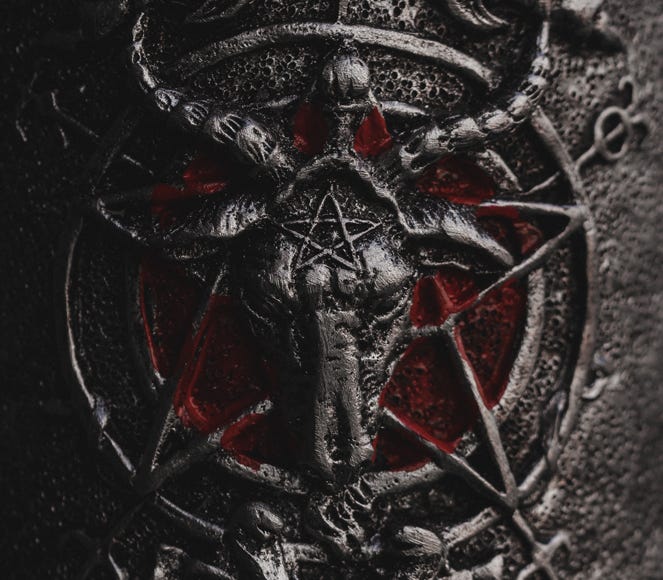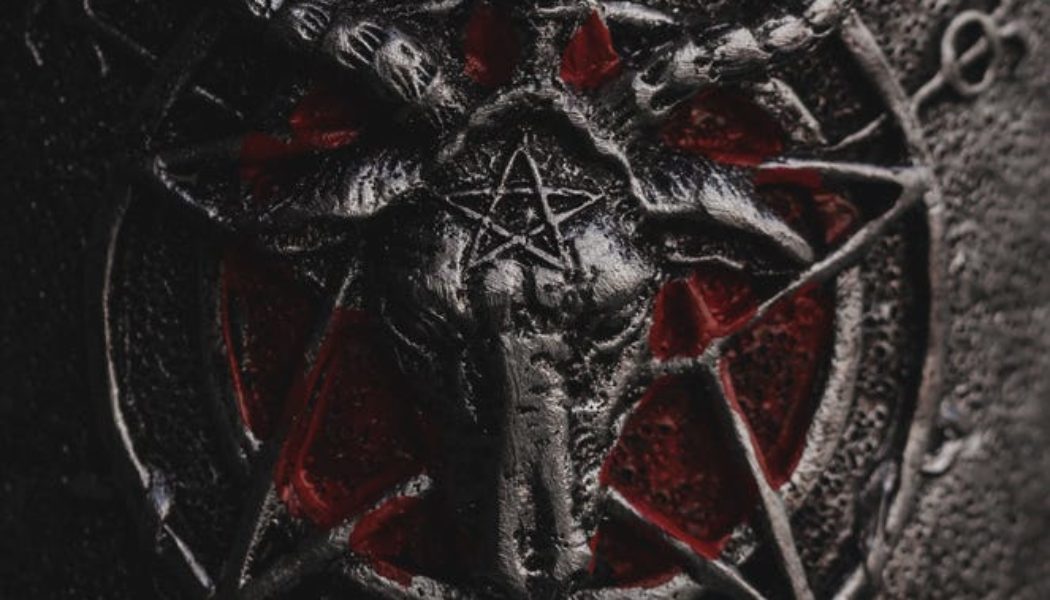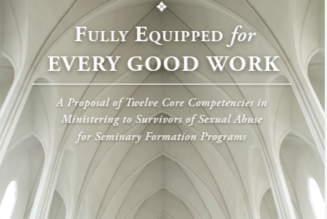
The devil is back on the Big Screen in the 2023 film “The Pope’s Exorcist.” But he never really left the stage. He’s not a metaphor. He’s not a fairytale. And as awkward as it might seem to an urbane and modern world, we need to take his existence, and his role in human affairs, seriously.
Leszek Kolakowski was one of the great minds of the last century. He was a leading Marxist philosopher in Poland until he began asking unpleasant questions about life in the Soviet Union under Stalin. That kind of indiscretion got him silenced. Then it got him exiled to the West. He went on to become one of the 20th century’s most productive men of letters.
Kolakowski gave a very curious talk at Harvard in 1987 entitled “The Devil in History.” Many of the people in the audience knew Kolakowski’s work. They knew he could be playful. They knew he had a wicked sense of irony. So they might have expected him to make a few sardonic jabs at a dead religious myth.
What they got was something quite different.
Sitting in the audience that day were the political commentators Tony Judt and Timothy Garton Ash. Halfway into Kolakowski’s talk, Ash—astonished—leaned over to Judt and whispered: “He really is talking about the devil.”
[1] And in fact, Kolakowski was doing exactly that . . . not ironically or skeptically, but quite literally.
It was one of those moments when the prejudices of our intellectual class were laid bare. Apart from Judt and Ash, most of the audience never imagined that an urbane, secularized, public intellectual, fluent in five languages, could really believe in religious nonsense like the devil and original sin. But he did.
In fact, Leszek Kolakowski’s growing respect for religious faith in the latter years of his career gave him the insight he needed to penetrate the heart of the 20th century and understand the forces shaping modern culture. Three quotations from Kolakowski’s work are especially worth considering.
Here’s the first: “The devil is part of our experience. Our generation has seen enough of it for the message to be taken extremely seriously.”
Here’s the second: “Evil is continuous throughout human experience. The point is not how to make one immune to it, but under what conditions one may identify and restrain the devil.”
And finally, here’s the third: “When a culture loses its sacred sense, it loses all sense.”
What Kolakowski realized is this: No matter how awkward some critics may find it, we can’t understand our culture unless we take the existence of Satan seriously. The devil is not a fantasy or a pre-scientific delusion. The devil is real. So is evil. Both are constantly at work in human history, and in the struggles that divide every human heart. What makes Satan implausible to the modern mind is his imagery in medieval art and poetry like Dante’s Inferno. But the childishness of our art and the inadequacy of our language in describing the profoundly personal, profoundly intelligent being we call “the devil,” should not delude us about his reality. If Jesus, the Apostles, and unbroken Christian tradition have believed in the presence of humanity’s Enemy, then we disbelieve at our peril.
Too often in our apostolate to the world we’re naive. Our mission isn’t about carving out some corner of secular culture to make it more “Christian.” It’s not about getting more Christian viewpoints in the media or more Christian values reflected in our various forms of art or political debates. Those things are important. But there’s more at stake.
The evangelization of culture is a call to spiritual warfare. We’re in a struggle for souls and our adversary is the devil. The first Christians knew this. Their awareness is written onto every page of the New Testament. Christians today need exactly the same mental framework. We face not only entrenched and often unfriendly cultural elites, but spiritual forces committed to the defeat of the Gospel.
The devil can’t ultimately prevail. But he can do great damage and bring many souls to ruin in the time remaining to him. Yet the devil is largely ignored nowadays, even in the Church. Every Easter we renew our baptismal vows in a ritual that includes a renunciation of Satan and all his empty promises. Do we understand what we’re saying? Do we really believe it? Then why did so many of us stop taking the devil seriously?
Kolakowski wrote a shrewd little satire about precisely this question. He titled it, “Shorthand Transcript of a Metaphysical Press Conference Given by the Demon in Warsaw, on 20th December, 1963.”
In this mock meeting with the media, the devil perceptively indicts the Church and believers for lusting after respectability and relevance to “the spirit of the times.” And the devil, no surprise, is right on target. We’re embarrassed about the devil—and frankly, about a lot of Catholic beliefs—because they’re held in contempt by today’s intellectuals, opinion arbiters, and captains of culture. Nobody enjoys being made fun of or derided as superstitious. We long to be respected by those who despise us.
In a self-confident, materialist world, it’s awkward to believe in the devil. But it’s also awkward to believe in Jesus Christ. And that’s the point. Medieval theologians understood this quite well. They had an expression in Latin: Nullus diabolus, nullus redemptor (No devil, no Redeemer). Without the devil, it’s hard to explain why God’s Son needed to take on human flesh, and then suffer and die for us. After all, what exactly did He redeem us from?
The devil more than anybody appreciates this irony: that we can’t fully understand Jesus Christ and His sacrifice without him. And he exploits this to his advantage. He knows that consigning him to myth inevitably sets in motion our same treatment of God. As Kolakowski’s devil says: “If you forsake the foundations of the faith for fear of mockery, where will it end?”
To evangelize today’s culture we need to start by acknowledging the reality of the devil. Then we need to recognize how the devil does his work.
Culture is the devil’s favorite arena. The first Christians called him “the ruler of the power of the air” and “the deceiver of the whole world.” Tertullian, writing near the end of the second century, said Rome’s entire entertainment culture—the circus, theater, wrestling, gladiatorial games—was owned and operated for the devil’s sake, to erode the individual conscience and corrupt public morals.
The devil works in similar ways in the modern world. The philosopher Raissa Maritain, writing in the 1930s, suggested that the devil tries especially hard to misdirect the work of artists, philosophers, and scientists. This is an important insight. Humans are made, as Scripture tells us, a little lower than angels and in the image of God. This is why we’re able to create such extraordinary works of art, music, architecture, philosophy, and technology.
Yet precisely because our works in such areas can be so exalted, they’re also the most vulnerable to demonic interference. Pride comes before a fall, and the devil always delights in our vanities. As Maritain said so poetically, the devil “knows all the secrets of [man’s] feelings and imagination, all the resources of intoxicating rapture in this world—a double keyboard upon which he combines the stops of voluptuousness and art, of knowledge and power.”
As a result, the ideology of modern art, and much of the useless debris that fills today’s art galleries and auction houses, point to a crisis of beauty and meaning. Without religious inspiration, our art has no coherent subject matter, no meaningful principles of aesthetic order and value, and no higher purpose than the self-expression of the individual artist’s private universe.
Art has thus grown increasingly chaotic and anti-human. The tragedy of modern art is marked by the defilement, disfigurement, or outright disappearance of the human person. Compare the luminous strength of Michelangelo with the freakish work of so many recent artists; the difference is striking.
Culture reflects what a people believe about ultimate things. And to judge from our cultural discourse and artifacts, we no longer really believe in the unique worth of the human person. This is what Leszek Kolakowski meant when he said that a culture that loses its sacred sense, stops making sense. When a culture loses sight of God, it loses sight of man as well.
And this is the culture we’re called to evangelize.
It’s our task, here and now, to turn the eyes of others toward the beauty of the world that God has created—and to point them to the beauty that awaits us in the world to come. We need to help those around us to see the Love that sustains the world; the Love that became flesh and blood. The Love that has shown His face to us in Jesus Christ.
We’re made for this Love—each one of us. The human heart instinctively yearns to praise the God who is Love incarnate. It’s to keep us from this Love that the devil undertakes his work. And he’ll never stop seeking to subvert the natural song of love in the human spirit. Yet in the end, the devil is nothing. God is all. And one day we’re meant to encounter this Love in person. That’s why we were created. That’s what Satan so jealously resents. We will see what Dante saw and overwhelmed him at the end of his Divine Comedy, the long road that led him from the depths of hell, through purgatory, and into the heights of heaven. We will meet, face to face . . . “The Love that moves the sun and the other stars.”
+Charles J. Chaput is the archbishop emeritus of Philadelphia. This essay is revised and adapted by the author from remarks originally delivered to Rome’s Emmanuel Community.









